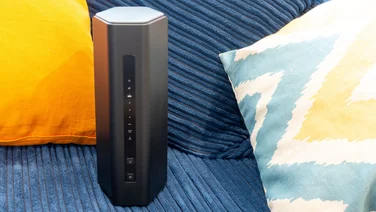To help us provide you with free impartial advice, we may earn a commission if you buy through links on our site. Learn more
- Asus ROG Rapture GT-AXE11000 router review: What you need to know
- Asus ROG Rapture GT-AXE11000 review: Price and competition
- Asus ROG Rapture GT-AXE11000 router review: Hardware design
- Asus ROG Rapture GT-AXE11000 router review: Software features
- Asus ROG Rapture GT-AXE11000 router review: Performance
- Asus ROG Rapture GT-AXE11000 router review: Verdict

- Excellent software features
- High-speed connections for both wired and wireless clients
- Network security and parental controls bundled into the price
- Not as fast as the competition
The ROG Rapture GT-AXE11000 is Asus’ latest flagship gaming router. It’s loaded with features that make it easy to set up online gaming connections and to ensure they get top priority over any other network activity.
Although the GT-AXE11000 supports the new Wi-Fi 6E standard, we found its wireless performance wasn’t as fast as we’d hoped. However, it also has a super-speed 2.5Gbits/sec Ethernet port and a load of great capabilities for both gaming and general home network management that very few other routers can match.
READ NEXT: The best wireless routers for faster Wi-Fi at home
Asus ROG Rapture GT-AXE11000 router review: What you need to know
The GT-AXE11000 is Asus’ first router of any type to support the new Wi-Fi 6E standard. If you have a compatible computer or network card you can connect to it on the newly licensed 6GHz radio band, and avoid interference from other devices in your home and next door.
At the same time, it will work perfectly well with older devices. There’s full support for Wi-Fi 5 and regular Wi-Fi 6, with claimed transmission speeds of up to 4.8Gbits/sec and 4×4 MU-MIMO. Wired connections are well covered, too, with four Gigabit Ethernet ports in addition to the 2.5GbE socket.
Asus ROG Rapture GT-AXE11000 review: Price and competition
At £480 the GT-AXE11000 is expensive, but if you’re looking for a specialist gaming router with Wi-Fi 6E there currently isn’t another choice. The only other 6E-enabled router we’ve seen so far is the Netgear Nighthawk RAXE500, which costs even more (a snip at £550) and lacks any gaming-oriented features. It does, however, currently wear the crown for performance, so if you’re focused on raw speed, the Netgear is well worth a look.
Another potential alternative is the Asus Rapture ROG GT-AX6000. This has the same gamer-focused design as the GT-AXE11000 and even ups the connectivity ante with support for 2.5GbE on both WAN and LAN connectors. The GT-AX6000 doesn’t support Wi-Fi 6E but it impressed us with the speeds it delivered over a regular Wi-Fi 6 link and, at £300, it’s significantly cheaper.
Then there’s the Asus TUF Gaming AX5400, a more lightweight Wi-Fi 6 router that has limited gaming features but slashes the price to just £120. Non-gaming options include the versatile Asus RT-AX82U, which will set you back £180, or the hugely affordable D-Link DIR-X1860, now available for £90.
Asus ROG Rapture GT-AXE11000 router review: Hardware design
The GT-AXE11000 is a chunky slab of plastic measuring 250mm square, not including the eight antennas festooned around its edges. A row of small white LEDs along the front show internet, wired and wireless connectivity status, while a set of clicky buttons at the opposite corner let you toggle Wi-Fi on and off, enable WPS connections and engage the Game Boost mode, which I’ll get onto below.
At the rear you’ll find four Gigabit Ethernet sockets plus a 2.5GbE connector. As always, it’s a bit limiting to have only one multi-gigabit port, so if you want to get two computers talking to one another at full speed you’ll need an external 2.5GbE switch. It is possible to combine two of the regular LAN ports into a single 2Gbits/sec connection, however, and the 2.5GbE port can also be used for a multi-gig internet connection, should you be lucky enough to have one.

Tucked away at the left-hand side, a pair of USB-A 3.2 Gen 1 (5Gbits/sec) sockets allow you to connect external storage for NAS-style file sharing, or take advantage of the GT-AXE11000’s built-in media server and Time Machine capabilities. You can also share a USB printer or connect an Android phone to use its mobile internet connection in place of a regular cabled service, which could be very handy for emergencies.
On the top, the glowering ROG logo glows red by default but, if that seems dull, you can choose from a variety of multicoloured light shows, or set it to change colour to reflect the router status.
Asus ROG Rapture GT-AXE11000 router review: Software features
The ROG Rapture GT-AXE11000 runs Asus’s dedicated Gaming Router firmware, which puts gaming front and centre. You don’t even need to delve into the settings to take advantage: by default, any device connected to the 2.5GbE socket automatically gets priority over other clients, ensuring that your gaming PC or console won’t be bogged down by other family members watching Netflix or talking on Zoom.
Open the web console and you’ll find numerous other gamer-friendly options. You can nominate any number of clients as gaming devices, and turn on the Game Boost option to automatically prioritise packets from popular gaming titles and platforms ahead of all other traffic. You can use the boost button on the front of the router to toggle this feature, although in the default configuration it does nothing more than turn the main LED on and off.

Another handy feature is the ability to apply pre-configured port-forwarding rules for a large library of games, enabling you to set up online play with a few clicks, while the Game Radar tool checks worldwide server speed and latency for selected gaming titles, so you can see at a glance which location will give you the best performance.

As usual with Asus, there’s also an impressive spread of regular router controls for those who want them. Those include full control over your wireless settings and channels, with up to three isolated guest networks on each band, plus customisable per-device and per-application QoS.

You can set up a secondary internet connection, too, just in case your main one goes down, and I love the VPN Fusion feature that lets you configure up to 16 different VPN connections and send different clients’ traffic to different servers.
On top of that, Asus’ AiProtection module – offered in partnership with security specialist Trend Micro – scans your network for vulnerabilities, blocks malicious websites and quarantines infected clients. If you have kids, you can set timetables for their internet access, and optionally block them from accessing adult websites, peer-to-peer sharing servers and instant messaging services. It isn’t the most comprehensive set of restrictions in the world but, considering Netgear charges annual subscriptions for its security and parental control services, it would be churlish to complain.
Asus ROG Rapture GT-AXE11000 router review: Performance
The fastest Wi-Fi 6E router we’ve previously seen is the Netgear Nighthawk RAXE500 and, on paper, the GT-AXE11000 should be more than a match for it. It claims the same top speed of 4.8Gbits/sec, but also supports the maximum 160MHz channel width on both 5GHz and 6GHz bands, whereas the Netgear only goes up to 80MHz for regular Wi-Fi 5 and 6 connections.


I tested real-world performance in my usual way: by setting up the ROG Rapture GT-AXE11000 in my study and connecting an Asustor Drivestor 4 Pro appliance over 2.5GbE. I then carried a Wi-Fi 6E-enabled laptop to various locations in my home and copied a set of 100MB data files to and from the NAS, using regular Wi-Fi 6 on the 5GHz band and Wi-Fi 6E over 6GHz. The average download and upload speeds I saw are shown below, along with the speeds attained in the same tests by the other routers mentioned above.
The GT-AXE11000 indisputably earns its place in the upper tier of wireless routers. Upload speeds approached an excellent 40MB/sec at short range, and download speeds were more than three times as fast.
Yet it isn’t as impressive as expected. No matter where I wandered, the Netgear Nighthawk RAXE500 was a clear length ahead on both frequency bands. The gap was particularly pronounced in the mid-range bedroom and kitchen locations, where the Netgear proved around twice as fast as Asus’ flagship.
Perhaps it’s to be expected that the GT-AXE11000 would lose out to a router costing £80 more. What’s embarrassing is that the GT-AXE11000 also struggled to keep up with its own cheaper stablemate, the GT-AX6000. Although that router doesn’t support Wi-Fi 6E, the download speeds it delivered over a standard 5GHz link were strongly competitive with the GT-AXE11000’s 6GHz speeds, actually beating it in three out of the six test locations.
I have an inkling as to why this might be. While the ROG Rapture GT-AXE11000 is new to the UK, the first units started popping up in the US as long ago as March 2021. In other words, it’s a very early implementation of Wi-Fi 6E. By contrast, the GT-AX6000 really is a brand new model, and it makes use of Asus’ very latest Wi-Fi 6 radio design, enabling it to keep up surprisingly well with a first-generation 6GHz connection.
Asus ROG Rapture GT-AXE11000 router review: Verdict
If you’re looking for a router with the broadest set of gaming optimisations, look no further. It doesn’t hurt that it’s also deliciously easy to use, has a fantastic set of regular router features, and – depending on how you feel about the gamer aesthetic – even looks somewhat badass.
However, when a new top-of-the-range gaming router ushers in the latest and greatest Wi-Fi standard, you’re entitled to expect game-changing speeds. It would be a stretch to say that this router delivers those.
Let’s not be too harsh. In the midst of an online battle I seriously doubt you’d notice any difference between this and the Netgear Nighthawk RAXE500 – unless, perhaps, you were relying on a wireless connection from several rooms away. And the most serious gamers are likely to use a wired connection, so they’ll be more than satisfied with the 2.5GbE provision.
Yet it’s hard to overlook the fact that the ROG Rapture GT-AX6000 offers an exceedingly similar package for £180 less. What’s more, because that model achieves its excellent performance over a standard 5GHz link, your current Wi-Fi 6 devices can get the benefit right now, with no need to replace them with 6E-compatible models.
No doubt, when the ROG Rapture AXE11000 first appeared last year it represented an impressive debut for Wi-Fi 6E. Today, with newer rivals beating it on price and performance, it’s sadly hard to see why this router would be anyone’s first choice.






